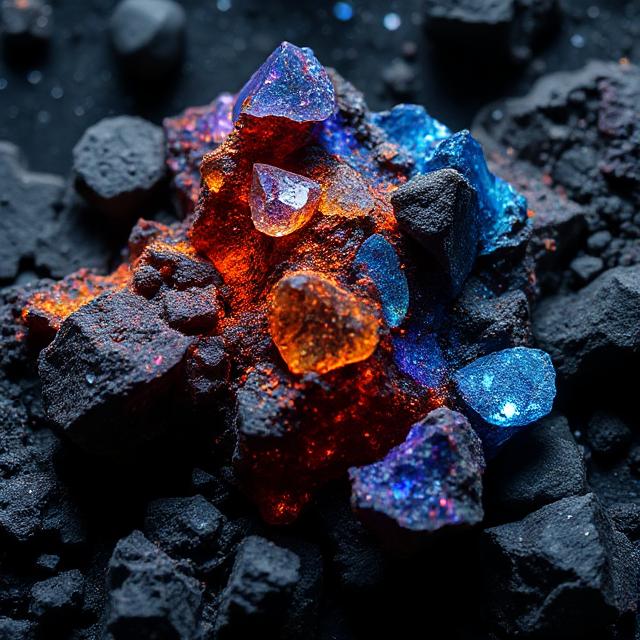Rare Earth Elements: The Hidden Power Behind Modern Technology and Global Geopolitics
Introduction: Why Rare Earth Elements Matter
Rare earth elements (REEs) are the unsung heroes of modern technology. From the smartphone in your pocket to the jet engines that guard national skies, REEs are everywhere. Despite their name, these elements are not particularly “rare” in terms of abundance. Instead, their rarity lies in the economic, political, and technological complexities of mining, refining, and commercializing them.
In today’s rapidly evolving global economy, rare earth elements are more than just industrial commodities—they are strategic assets. Countries like China, India, the U.S., and Australia are competing to control supply chains, while industries ranging from defense and aerospace to semiconductors, automotive, and renewable energy depend heavily on these critical minerals.
This article takes a comprehensive look at rare earth elements—what they are, their history, their applications, and their role in geopolitics and business strategy.
What are Rare Earth Elements?
- Definition: Rare earth elements are a group of 17 elements in the periodic table, including 15 lanthanides, plus scandium and yttrium.
- Rare Earth Elements List:
- Lanthanum (La)
- Cerium (Ce)
- Praseodymium (Pr)
- Neodymium (Nd)
- Promethium (Pm)
- Samarium (Sm)
- Europium (Eu)
- Gadolinium (Gd)
- Terbium (Tb)
- Dysprosium (Dy)
- Holmium (Ho)
- Erbium (Er)
- Thulium (Tm)
- Ytterbium (Yb)
- Lutetium (Lu)
- Scandium (Sc)
- Yttrium (Y)
These elements have exceptional magnetic, luminescent, and electrochemical properties, making them indispensable to high-tech applications.
History and Discovery
- Rare Earth Elements Discovery:
The story began in 1787 when Swedish army officer Carl Axel Arrhenius discovered an unusual mineral in a quarry in Ytterby, Sweden. Over the next century, chemists identified new elements from this mineral, giving rise to the “rare earth” family. - Rare Earth Elements History in Industry:
Initially, REEs were curiosities in laboratories, but by the 20th century, they powered color televisions, nuclear fuel cycles, and advanced electronics.
Rare Earth Elements in India
India is home to significant deposits of monazite sands along its eastern coast (Odisha, Kerala, Andhra Pradesh, Tamil Nadu). While India holds 6% of the world’s rare earth elements deposits, it lags in large-scale processing and refining.
- Rare Earth Elements India – Current Scenario:
- Managed largely by Indian Rare Earths Limited (IREL), a public sector enterprise.
- India’s deposits are rich in cerium, lanthanum, and neodymium.
- Applications include defense, nuclear energy, and renewable industries.
- However, India still imports processed REEs from China due to limited refining capacity.
Global Distribution and Production
- Rare Earth Elements Countries & Deposits:
- China: Controls 60–65% of global production and nearly 90% of refining.
- USA: Mountain Pass mine in California.
- Australia: Lynas Rare Earths, one of the few non-Chinese producers.
- India, Brazil, Vietnam, Russia: Significant reserves but underdeveloped supply chains.
- Rare Earth Elements Deposits by Country (2024 estimates):
- China – 44 million metric tons
- Vietnam – 22 million metric tons
- Brazil – 21 million metric tons
- Russia – 12 million metric tons
- India – 6.9 million metric tons
- Rare Earth Elements Cost:
Prices vary widely. Neodymium oxide costs$70,000 per ton, while cerium oxide is far cheaper ($5,000 per ton). The cost is influenced by purity, demand, and strategic control.
Extraction, Processing, and Manufacturing
- Rare Earth Elements Extraction Process:
Extracted primarily through open-pit mining, followed by chemical separation and refining. This is energy-intensive and environmentally challenging due to radioactive byproducts (thorium and uranium). - Rare Earth Elements Processing Plants:
China dominates, but plants are emerging in Australia, USA, and India to diversify global dependence. - Rare Earth Elements Manufacturers & Exporters:
- China Northern Rare Earth Group (China)
- Lynas Rare Earths (Australia/Malaysia)
- MP Materials (USA)
- IREL (India)
Applications Across Industries
Rare Earth Elements Applications
- Magnets: Neodymium, dysprosium, and terbium for high-performance magnets in wind turbines, EVs, and defense.
- Semiconductors: Europium and yttrium in chip manufacturing.
- Batteries: Lanthanum and cerium in nickel-metal hydride and future solid-state designs.
- Automotive Industry: Electric vehicles rely heavily on neodymium magnets for motors.
- Nuclear Fuel: Samarium and gadolinium are neutron absorbers in nuclear reactors.
- Defense & Aerospace: Jet engines, guidance systems, sonar, and missile technology.
- Green Energy: Wind turbines, solar panels, hydrogen storage.
- Consumer Electronics: Smartphones, laptops, televisions, speakers.
Geopolitics of Rare Earth Elements
- Rare Earth Elements China:
China weaponizes REE dominance, restricting exports to control global supply. For example, in 2010, China restricted REEs to Japan, sparking global panic. - Rare Earth Elements Geopolitics:
- US-China tensions have placed REEs at the center of trade wars.
- Quad nations (India, USA, Japan, Australia) are forming alliances to secure alternative supply chains.
- The EU has declared REEs as “critical raw materials” and is seeking trade partnerships.
- Rare Earth Elements Policy & Regulation:
Countries are now drafting policies to secure REE supply, focusing on:- Domestic mining & processing.
- Recycling from electronic waste.
- International partnerships.
Human Health & Environmental Impacts
- Rare Earth Elements Human Health:
While not directly toxic in low doses, mining and refining produce hazardous waste, including radioactive materials. Exposure risks include lung disease, skin irritation, and kidney damage. - Environmental Issues:
- Soil and water contamination from tailings.
- Biodiversity loss in mining areas.
- Calls for greener extraction technologies.
Business, Markets, and Stock Insights
- Rare Earth Elements Production & Market Trends:
Demand for REEs is expected to grow 400–600% by 2040 due to clean energy and EV adoption. - Rare Earth Elements Stock Price Movements:
Public companies like Lynas and MP Materials have surged in valuation as REEs gained strategic importance. - Rare Earth Elements Report Forecasts:
Analysts project a $20 billion+ global market by 2030, with CAGR of 10–12%. - Investment Opportunities:
- Mining companies (Lynas, MP Materials).
- Recycling technologies.
- Rare earth ETFs and commodity funds.
The Future of Rare Earth Elements
- Rare Earth Elements for Batteries & Semiconductors:
With EVs and AI chips demanding more REEs, future innovations may reduce dependence but not eliminate it. - Technological Shifts:
- Recycling from e-waste.
- Substitute materials research.
- AI-driven mining efficiency.
- India’s Role:
If India invests in refining and partnerships, it could emerge as a global REE powerhouse, reducing overdependence on China.
Conclusion: The Strategic Metals of the 21st Century
Rare earth elements are not just minerals—they are the backbone of the 21st-century economy. From magnets to missiles, semiconductors to solar panels, they are critical to industrial progress, national security, and green energy transitions.
For researchers, they present cutting-edge challenges.
For businesses and investors, they represent a growing market with high barriers to entry.
For policymakers, they demand careful strategy to secure supply chains.
As the world moves toward a future dominated by clean energy, digitalization, and defense innovation, rare earth elements will only grow in importance. The question is not whether REEs matter—but which countries and companies will control them.












